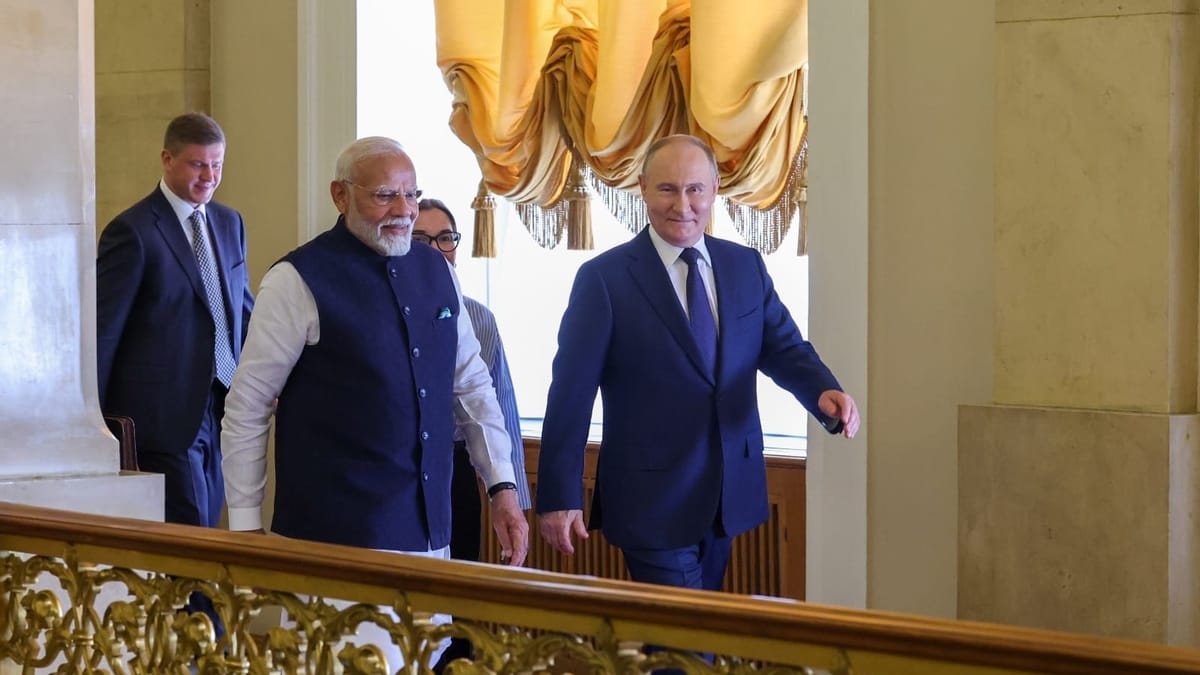
India and Russia share a long-standing partnership, which has been a cornerstone of India's foreign policy. The relationship gained momentum with the signing of the Declaration on the India-Russia Strategic Partnership in 2000, elevating cooperation in defence, trade, economy, science and technology, culture, and people-to-people ties. In 2010, this partnership was upgraded to a Special and Privileged Strategic Partnership. Both countries maintain institutional dialogue mechanisms through the India-Russia Intergovernmental Commission (IRIGC), covering trade, economic, military, and technological cooperation.
India-Russia ties have increasingly become important in the current global context of shifting geopolitical alliances. As the world grapples with the impact of the Ukraine war, India's diplomatic balancing act is critical. Prime Minister Narendra Modi’s visit to Moscow in July 2024 underscores the enduring significance of this partnership, particularly as Western sanctions have pushed Russia to deepen economic links with non-Western powers like India and China.
Bilateral Trade
Improved connectivity through initiatives such as the International North-South Transport Corridor and the Chennai-Vladivostok maritime route aims to enhance logistics between the two countries. Direct cargo flights and shipping routes are expected to reduce transport costs and expedite trade.
India-Russia trade surged to a record $65.7 billion in 2023, primarily driven by India’s imports of Russian oil, coal, fertilisers, and precious metals. Russia is now India's second-largest source of imports, after China. However, the trade balance remains skewed, with India importing goods worth $61.4 billion while exporting significantly less to Russia. The Joint Statement following the latest India-Russia Annual Summit highlights this growth, achieving nearly double the $30 billion target set by their leaders for 2025. Both sides expressed satisfaction with this progress and emphasised the need for balanced and sustainable long-term trade. The leaders stressed increasing Indian exports to Russia through enhanced industrial cooperation, new technological and investment partnerships—particularly in advanced high-tech sectors—and exploring new avenues for collaboration. They have set a new bilateral trade target of $100 billion by 2030.
Russian Rupees
The shift towards national currency transactions has accelerated, with payments in rupees and rubles doubling since 2023. Sberbank, Russia’s largest bank, reported a sixfold increase in corporate rupee deposits, underscoring the growing trust in the Indian currency. The two nations are also working towards a Free Trade Agreement with the Eurasian Economic Union.
Russia has addressed the issue of billions of rupees accumulating in Indian banks by investing in Indian stocks and infrastructure projects. These funds were held in Special Rupee Vostro Accounts (SRVAs), set up after India increased purchases of discounted Russian crude in 2022, following Moscow's exclusion from SWIFT –the global payment system. Russia has utilised the rupees in SRVAs for investments, and while trade continues mainly in national currencies, some energy payments are made in UAE dirhams.
Energy Cooperation
India’s energy partnership with Russia has deepened significantly, especially in oil and gas, marking a crucial element of their Special and Privileged Strategic Partnership. India heavily relies on energy imports, sourcing almost 85% of its oil needs. Following geopolitical shifts after Russia's invasion of Ukraine, Indian oil imports from Russia surged. By 2024, Russia supplied around 41% of India’s crude oil, a sharp rise from just 2% pre-invasion. Russian crude oil deliveries to India hit a record 2.1 million barrels per day in April 2024, highlighting the growing energy partnership amidst Western sanctions on Russia.
Notably, Indian energy giants Reliance Industries and Nayara Energy, partly owned by Russia’s Rosneft, have strengthened ties with Russian suppliers. These companies have benefitted from discounted Russian oil, boosting India’s refining and re-export business. Looking ahead, the partnership is set to expand, targeting trade of $100 billion by 2030, which includes increasing oil imports, coal supplies, and potential collaborations in renewable energy. Recent projects, such as the Kudankulam Nuclear Power Plant expansion and oil ventures like Nayara Energy, continue to strengthen bilateral economic ties. Despite Western sanctions on Russia, India’s approach remains pragmatic, focusing on securing affordable energy to fuel its growing economy.
Defence Cooperation
India's defence relationship with Russia has long been central to its military procurement. While recent data shows a decline in Russia's share of India's defence imports, now standing at 36%—the lowest since the 1960s—technological collaborations continue to bind the two nations. The India-Russia Annual Summit highlighted this evolving partnership, with both sides committed to joint research, co-development, and production of advanced military technologies. India’s Make in India initiative is reshaping the relationship, focusing on local manufacturing of Russian-origin defence equipment and spare parts, along with technology transfers.
Emerging Sectors of Collaboration
India and Russia have strengthened collaboration in satellite launches and space exploration. The partnership between the Indian Space Research Organization (ISRO) and the Russian State Space Corporation, Roscosmos, focuses on the peaceful use of outer space, including human spaceflight programmes, satellite navigation, and planetary exploration. The two sides have agreed to explore opportunities in rocket engine development and production.
Information technology (IT) collaboration has expanded, underscored by a Memorandum of Understanding between RUSSOFT, the Association for the Export of Technological Sovereignty, and the Russia India Special Interest Group (RISING). This agreement aims to strengthen bilateral ties in IT, improve the development and production of IT solutions, and promote employment growth in the sector.
The significance of the India-Russia strategic partnership is further underscored by the progress made in constructing the remaining nuclear power plant units at Kudankulam. Both sides reiterated their commitment to adhering to the project schedule and discussed further cooperation for a second site in India. The intention to broaden collaboration in nuclear power includes support for fuel cycles, lifecycle management for operational plants, and non-power applications.
Joint industrial projects between India and Russia are thriving, particularly in metallurgy, railways, and electronics. India's Make in India initiative has attracted several Russian companies, with collaboration extending to telecommunications, cybersecurity, and artificial intelligence. Indian companies are also being encouraged to explore opportunities in the Russian market, which is seeing reduced competition from Western firms due to sanctions. Beyond commerce, cultural and educational exchanges are expanding, with more Indian students pursuing studies in Russia and increased tourism expected as bilateral relations deepen.
Both sides identified potential areas for future collaboration in agriculture, the marine industry, health and medical technology, data science, and nanotechnology, reflecting the expansive nature of the strategic partnership. The implementation of joint research projects between India's Department of Science & Technology and the Ministry of Science and Higher Education of the Russian Federation further reinforces this growing relationship.
Strengthening Ties
While India’s stance on the Ukraine war remains neutral, the surge in bilateral trade, particularly in energy, reflects pragmatic cooperation. India and Russia's long-standing partnership has evolved into an alliance underscored by mutual benefits in trade and economics. With bilateral trade soaring to a record $65.7 billion and substantial investments flowing into energy, defence, and technology, both nations are well-positioned amidst shifting global dynamics. The leaders have set an ambitious target of $100 billion for bilateral trade by 2030, reflecting their commitment to further deepen cooperation. As geopolitical landscapes continue to transform, this partnership can adapt by focusing on emerging sectors like renewable energy and advanced technology, reinforcing their strategic ties.

